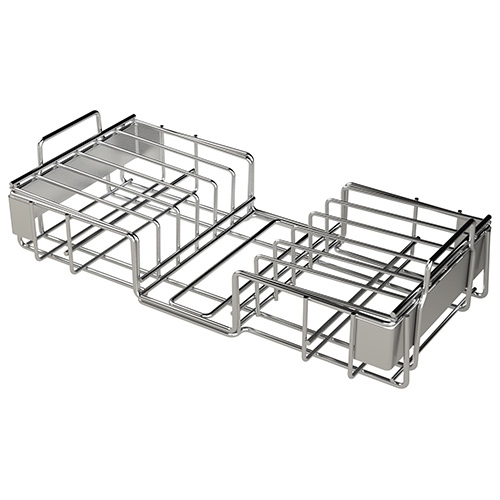When it comes to material handling equipment, durability, efficiency, and long-term value are critical considerations. Businesses across industries such as automotive, food processing, warehousing, and pharmaceuticals rely heavily on carts, racks, and baskets to transport, store, and organize components. While plastic solutions may seem like a cost-effective option upfront, stainless steel consistently outperforms plastic in nearly every critical aspect of material handling. In this article, we’ll explore the key advantages of stainless steel over plastic and why it remains the preferred choice for industries that demand strength, cleanliness, and longevity.
Durability and Longevity
Stainless is engineered for strength. Unlike plastic, which can warp, crack, or degrade under heavy loads or repeated use, stainless steel maintains its structural integrity over time. This durability makes it an ideal choice for custom stainless steel carts and industrial wire baskets that must withstand daily wear in tough environments. For companies seeking a long-term investment, stainless equipment can last decades with proper care, significantly reducing replacement costs compared to plastic alternatives.
Heat and Chemical Resistance
In industries where exposure to heat, chemicals, or cleaning solutions is common, stainless steel holds a clear advantage. Plastic materials can soften, deform, or absorb chemicals over time, leading to contamination risks and premature failure. Stainless, on the other hand, is resistant to high temperatures and maintains its strength even under extreme conditions. This makes it particularly valuable in food processing, pharmaceuticals, and parts washing applications where sanitation and reliability are non-negotiable.
Superior Hygiene and Sanitation
One of the most critical differences between stainless and plastic lies in hygiene. Stainless has a non-porous surface, making it resistant to bacteria, mold, and other contaminants. Plastic, by contrast, can develop scratches and microscopic pores that trap dirt and harbor bacteria. This is a key reason stainless is the standard in industries where cleanliness is paramount, such as medical facilities and food production. Equipment like medical wire baskets or pharmaceutical cleanroom equipment depend on stainless steel’s ability to meet strict hygiene requirements.
Load Capacity and Structural Strength
Material handling often involves moving heavy components, from automotive parts to stacked bakery trays. Stainless racks and carts are designed to manage these loads without bending or breaking, unlike plastic carts that may fail under pressure. Solutions such as heavy-duty pallet carts and gravity flow racks demonstrate how stainless can be engineered to handle demanding applications with ease. This structural strength reduces the risk of equipment failure and enhances worker safety.
Environmental Sustainability
While plastic is often viewed as a cheaper material, its environmental impact is significant. Most plastics are not biodegradable and may not be recyclable depending on their composition. Stainless, by contrast, is 100% recyclable and can be repurposed without loss of quality. Investing in stainless steel carts, baskets, and racks not only benefits operations but also aligns with sustainability initiatives that many modern companies are pursuing to reduce waste and improve eco-friendly practices.
Cost Efficiency Over Time
Although stainless may involve a higher initial investment compared to plastic, its longer lifespan and reduced maintenance needs make it far more cost-effective over time. Businesses that replace plastic carts or racks every few years will often find stainless steel pays for itself within a single equipment lifecycle. By reducing downtime, replacement costs, and sanitation risks, stainless steel offers a true return on investment.
Applications Across Industries
From automotive manufacturing to commercial bakeries, stainless steel products have proven to be versatile and reliable. Automotive facilities rely on stainless steel carts to transport heavy parts efficiently. Food processors use stainless racks and baskets to meet sanitation standards. Warehousing operations turn to stainless pallet carts and storage racks to maximize floor space and streamline logistics. The adaptability of stainless steel makes it suitable for virtually any material handling challenge.
Why Choose Salco Engineering for Stainless Steel Solutions
Salco Engineering specializes in designing and manufacturing custom stainless steel products tailored to industry-specific needs. From industrial carts to precision wire products, Salco’s expertise ensures every solution is built for maximum efficiency, safety, and durability. With decades of experience and a reputation for quality, Salco is the trusted partner for businesses looking to upgrade from plastic to stainless steel material handling solutions.
Conclusion: Stainless Steel Outperforms Plastic in Every Category
When comparing stainless to plastic in material handling applications, the advantages are clear. Stainless steel delivers unmatched durability, hygiene, load-bearing capacity, and long-term value. While plastic may appear to save costs initially, its limitations quickly outweigh the benefits in demanding environments. For businesses committed to efficiency, safety, and sustainability, stainless is the superior choice.
Take the Next Step
If your facility is considering upgrading from plastic to stainless equipment, Salco Engineering can help. Contact our team today to learn more about custom carts, racks, and baskets designed to fit your specific operations. Request a quote and see how Salco’s stainless steel solutions can transform your material handling processes.



